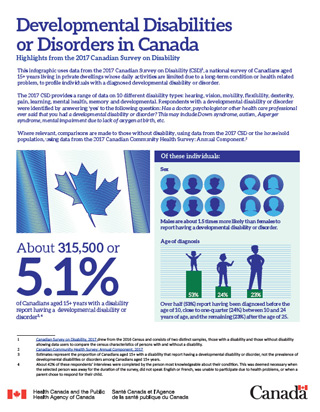Infographic: Developmental Disabilities or Disorders in Canada - Highlights from the 2017 Canadian Survey on Disability
Tell us what you think
Help us improve our products, answer our quick survey.
This infographic uses data from the 2017 Canadian Survey on Disability (CSD), Footnote 1 a national survey of Canadians aged 15+ years living in private dwellings whose daily activities are limited due to a long-term condition or health related problem, to profile individuals with a diagnosed developmental disability or disorder.
The 2017 CSD provides a range of data on 10 different disability types: hearing, vision, mobility, flexibility, dexterity, pain, learning, mental health, memory and developmental. Respondents with a developmental disability or disorder were identified by answering "yes" to the following question: "Has a doctor, psychologist or other health care professional ever said that you had a developmental disability or disorder? This may include Down syndrome, autism, Asperger syndrome, mental impairment due to lack of oxygen at birth, etc."
Where relevant, comparisons are made to those without disability, using data from the 2017 CSD or the household population, using data from the 2017 Canadian Community Health Survey: Annual Component.Footnote 2
About 315,500 or 5.1% of Canadians aged 15+ years living with a disability report having a developmental disability or disorder.Footnote 3,Footnote 4
Of these individuals:

Download the alternative format
(PDF format, 270 KB, 1 page)
Organization: Public Health Agency of Canada
Sex
Males are about 1.5 times more likely than females to report having a developmental disability or disorder.
Age at diagnosis
Over half (53%) report having been diagnosed before the age of 10, close to one-quarter (24%) between 10 and 24 years of age, and the remaining (23%) after the age of 25.
General healthFootnote 5
25% describe their general health as "excellent" or "very good", compared to 61% of the household population aged 15 years and older.Footnote 2
Mental healthFootnote 5
17% describe their mental health as "excellent" or "very good", compared to 70% of the household population aged 15 years and older.Footnote 2
Co-occurring disabilitiesFootnote 6
92% report a co-occurring disability, with learning disability being the most common (71%) followed by mental health related disability (57%).
Severity of disabilityFootnote 7
64% report having "severe" or "very severe" disability.
Support
75% report receiving help with at least one type of everyday activity, with the most common being:
- getting to appointments or running errands (58%)
- help looking after personal finances (56%)
- preparing meals (51%)
Aids or assistive devices
66% report using at least one aid or assistive device, with the most common being:
- computer with specialized software (20%)
- glasses (17%)
- wireless handheld device with specialized features (15%)
Education (aged 20+ years)Footnote 5
43% report having less than high school education, compared to 12% without disability.Footnote 1
Employment (aged 20 - 64 years)Footnote 5
31% report being employed, compared to 79% without disability.Footnote 1
Sources of income (aged 20 - 64 years)
- 17% employmentFootnote 8 only
- 61% non-employmentFootnote 9 only
- 19% both employment and non-employment
- 4%Footnote 10 no income
COVID-19 has brought unprecedented changes to Canadians. Data from the 2017 CSD were collected prior to the COVID-19 pandemic. The experiences presented within reflect the experiences and challenges of Canadians with developmental disabilities or disorders at the time of data collection. The pandemic may have exacerbated the challenges faced by an already vulnerable population. For additional information on COVID-19 and people with disabilities in Canada visit: https://www.canada.ca/en/public-health/services/diseases/2019-novel-coronavirus-infection/guidance-documents/people-with-disabilities.html
Follow us on social media:
- Facebook - @HealthyCdns
- Twitter - @GovCanHealth
Page details
- Date modified: